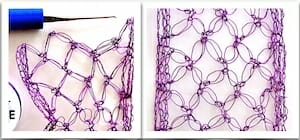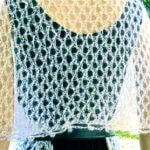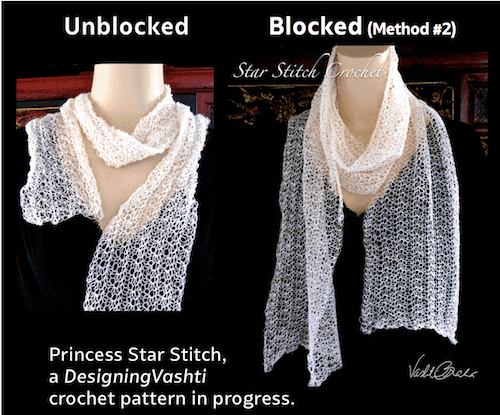View the high-res version of the above image.
Some of us only use one or two of these five, but you may discover that you use more blocking methods than you thought. (I hope we all use at least one!)
One of the methods below could be the perfect finishing touch for your next crochet project, depending on your yarn and project type. They’re listed from the gentlest to the most aggressive. It also depends on your own preferences. I’ve found that each crocheter has a favorite method.
Special considerations for a specific stitch, technique, or project follow.
1. Dry Block (the gentlest method)

I also think of dry blocking as “hand ironing”. Crocheters do this without even knowing that it has a name. Stretch, spread out, and flatten your crochet piece on something flat. One’s knee always seems to be nearby! Using one’s knee or upper leg is not too bad for a small item, especially if you’re wearing jeans or other fabric that provides a bit of friction. (Don’t use it for measuring a gauge swatch though.) If your surface is hard and flat, such as a table, you can also press it with your hands, i.e. “hand-iron” it.
I’ve read that some crocheters prefer the softer and more handmade look of their thread lace when they dry block it only. (Wet blocking thread crochet is more common, and it can include a stiffener; see below.)
Isn’t wire crochet a great way to illustrate dry blocking?
2. Damp Block
Also known as spray blocking and blocking with mist. Spritz liberally with water, especially the edges, then spread out on a toweled surface to dry. Use a bath towel on a flat surface; the towel offers some friction that I find in most cases replaces the need for pins.
This method is my personal favorite. I blogged about it back in 2010. I also combine it with methods 3 or 4 below: usually I damp block every 6″ to 12″ of rows while I’m crocheting, and then do a final wet block when you’ve completed the project. I like damp blocking partly because it’s the most portable, and partly because it’s fast. It works great for the types of yarn I tend to work with: bamboo, rayon, and plant fibers in general; also merino and alpaca. For most of the year here in humid Florida, wet things simply take too long to dry.
3. Wet Block
Wet blocking is when you fully immerse the crochet item in water. It’s a simple method that has several options for adding a whole range of effects to your projects. Practice wet blocking and it will develop into an art form. Try adding a fragrance, conditioner, fabric softener, or a stiffener to the water.
Depending on the yarn fibers and colorfastness, soaking can be a benefit or a liability. You can soak plant fibers like cotton, linen, hemp, rayon in warm or cool water a bit. This is Doris Chan’s favorite method.
For wools, immerse briefly in cool water to avoid fulling (felting), then remove excess water gently before spreading out on a toweled surface to dry. I like to add a little hair conditioner to the water if the yarn is wool or silk.
ShamWow super absorbent microfiber cloths are really helpful for speeding up the drying. I use them instead of, or on top of a bath towel on a table.
4. Steam Block
Steam blocking specifically uses the power of moist heat. This method can really pay off if you carefully test first. With practice you’ll develop the visual and tactile cues for how close to hold the steamer to your stitches and for how long, depending on the yarn. You’ll also develop a sense for which effects to aim for with a given yarn and stitch pattern.
Why risk using this rather aggressive blocking method? It can give acrylic yarns the sheen and drape of silk. Steam blocking is an art that can bring out extra softness and luster in some silk, camel, and llama fibers too.
5. Pin Block
Pin blocking includes stretching an item on blocking wires while wet or steamed. The most important thing about pinning is to use rust proof pins. I don’t own blocking wires, but I sure admire the knitted lace wraps that have been blocked with them. (Personally and non-professionally, I have only ever pinned crocheted snowflakes.)
Special Blocking Considerations
Picots
Tug and pinch each picot to round it out and make it visible, adding more water to them than the rest of the stitches, if necessary. Sometimes I roll each picot between my fingers to compress them and even out their roundness.
Love Knots
Most love knots are intended to be air-filled like a semi-inflated balloon. If yours are, spritz lightly with mist and damp block selectively: stretch and flatten stitches around the love knots. Gently smooth the love knots themselves so that you don’t flatten, deflate, stretch them out, nor weigh them down with too much water. You might feel like it’s not worth blocking them at all, but I tested this in my love knot classes and people could tell the difference.
Conversely, if you want yours to have the limp and collapsed look that is typical of the love knots in the tropics, feel free to wet block and perhaps even steam block them.
Lacy Tunisian Crochet

The lacy Tunisian crochet that I’ve done responds beautifully to wet blocking. Aim for squared filet eyelets. I tug strongly on the return pass lines to straighten, flatten, and lengthen them evenly. Tug vertically on extended Tunisian stitches to fully extend them, if you used them.
Garments
Wet blocking is the method here for the stylish fit, silhouette, and elegantly flowing, breezy movement many garments and accessories are intended to have. It’s no wonder that it’s Doris Chan‘s favorite method. Be sure to block the accessories that need to drape stylishly, such as wraps, scarves, collars, and even necklaces.
If you used acrylic yarn, steam blocking can bring out all the fashion drape and gleam, as if you used silk!
Note that steaming some animal fibers will soften them enough to wear against the neck.
Home Decor
Home decor projects, especially doilies, snowflakes, and afghan squares (also flowers and other appliques) usually need to be as perfectly flat and square, or round, as possible. Wet blocking with pins, wires, or dowels is common with these items. Sometimes starch is added (especially for snowflakes).
And finally…for all blocked items by all methods:
Let air dry completely, then admire your work and bask in the compliments!

